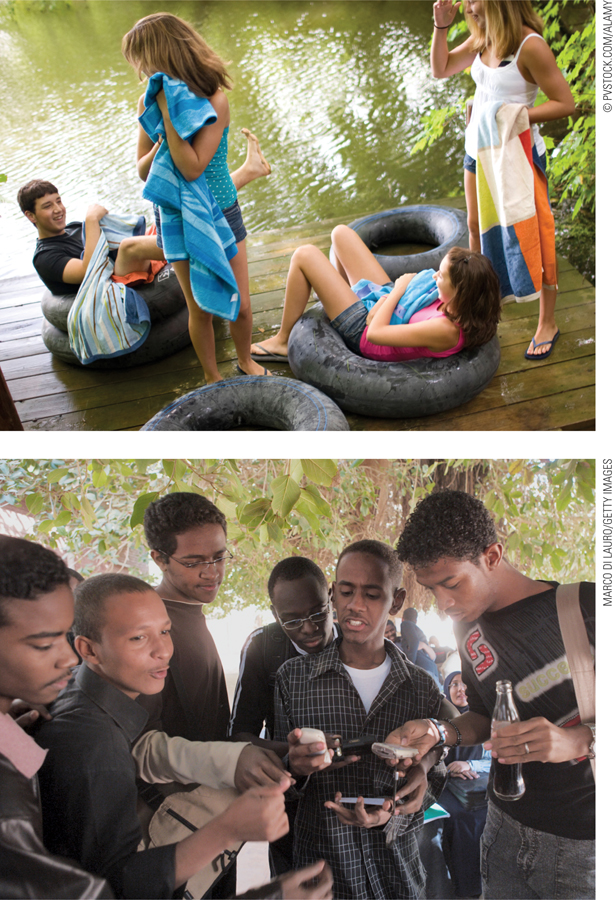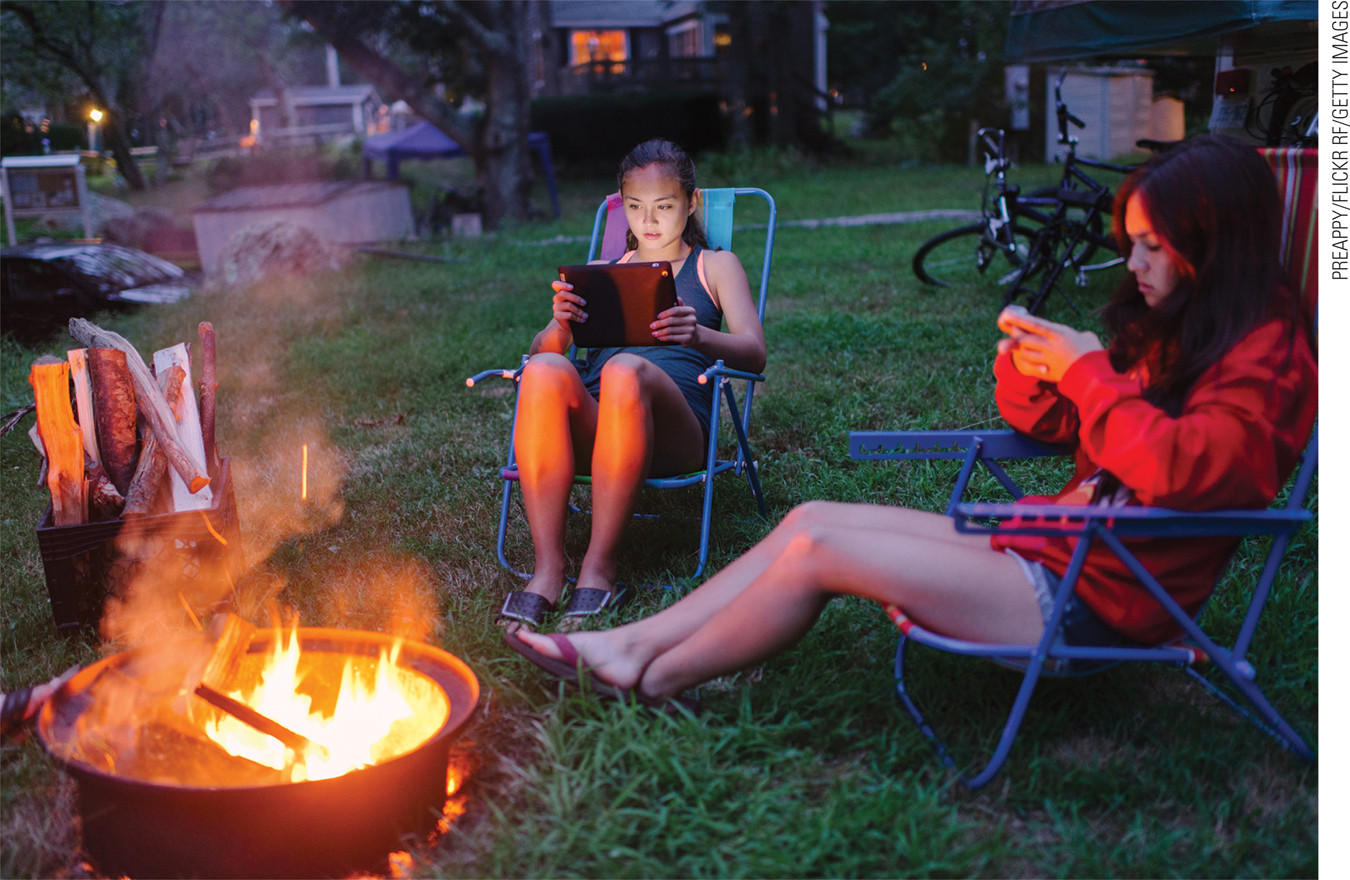Peer Power
Adolescents rely on peers to help them navigate the physical changes of puberty, the intellectual challenges of high school, and the social changes of leaving childhood. Friendships are important at every stage, but during early adolescence, popularity (not just friendship) is most coveted (LaFontana & Cillessen, 2010).
Question 16.13
OBSERVATION QUIZ There are dramatic differences among teenagers in these two nations as well. What three differences can you see?
(1) The U.S. friends are of both sexes; it's all boys in Sudan. (2) Inner tubes have recreational uses in the United States; they are used only for tires in Sudan. (3) The Sudanese boys are excited to show off their cell phones, which would be unlikely in the United States. There are also many differences in clothing, as you can see.

Peers and Parents
Adults are sometimes unaware of adolescents’ desire for respect from their contemporaries. I did not recognize this at the time with my own children:
Our oldest daughter wore the same pair of jeans in tenth grade, day after day. She washed them each night by hand and asked me to put them in the dryer early each morning. My husband was bewildered. “Is this some weird female ritual?” he asked. Years later, she explained that she was afraid that if she wore different pants each day, her classmates would think she cared about her clothes and then criticize her choices.
Our second daughter, at 16, pierced her ears for the third time. When I asked if this meant she would do drugs, she laughed at my naiveté. I later saw that many of her friends had multiple holes in their ear lobes.
At age 15, our third daughter was diagnosed with cancer. My husband and I weighed opinions from four physicians, each explaining treatment that would minimize the risk of death. She had other priorities: “I don’t care what you choose, as long as I keep my hair.” (Now her health is good, and her hair grew back.)
In sixth grade, our youngest refused to wear her jacket (it was new; she had chosen it), even in midwinter. Not until high school did she tell me she did it so that her classmates would think she was tough.
In retrospect, I am amazed that I was unaware of the power of peers.
Sometimes adults conceptualize adolescence as a tug of war between peers and parents, with the peers winning. This is not true. Relationships with parents are the prototype for peer relationships: Healthy communication and support from parents make constructive peer relationships likely. Both usually pull on the same side.
Parents and peers are often mutually reinforcing, although many adolescents downplay the influence of their parents and many parents are unaware of the influence of peers, as I was. Only when parents are harsh or neglectful does peer influence reign alone (Brown & Bakken, 2011).
Closeness to parents protects adolescent self-
Helpful friends can be of either sex. Although same-
Peer Pressure

Parents worry about peer pressure that is, they fear that peers will push their child to use drugs, break laws, and so on. If biological and social stresses are overwhelming, however, peers can be more helpful than harmful, especially in early adolescence. In later adolescence, teenagers are less susceptible to peer pressure, either positive or negative (Monahan et al., 2009). Some adolescents are more influenced by peers than others, because genes and early experiences differ (Prinstein et al., 2011; Choukas-
Peers are particularly needed by adolescents of minority and immigrant groups as they strive to achieve ethnic identity, attaining their own firm identity (not confused or foreclosed), understanding what it means to be Asian, African, Latino, and so on. The larger society provides stereotypes and prejudice, parents ideally describe ethnic heroes and reasons to be proud (Umana-
Then peers from the same background help with self-
The particular peers who are influential are those with the adolescent at the moment. This was found in a study in which all the eleventh graders in several public schools in Los Angeles were offered a free, online SAT prep course (worth $200) that they could take if they signed up on a paper the organizers distributed (Bursztyn & Jensen, 2014). Students were not allowed to talk before deciding whether or not to accept the offer, so they did not know that, although all the papers had identical, detailed descriptions of the SAT program, one word differed in who would learn of their decision—
The two versions were either:
Your decision to sign up for the course will be kept completely private from everyone, except the other students in the room.
or:
Your decision to sign up for the course will be kept completely private from everyone, including the other students in the room.
A marked difference was found if they thought their classmates would learn of their decision. The honors students were more likely to sign up, and the non-
To make sure this was a peer effect, not just divergent motivation and ability, the researchers compared 107 students who took exactly two honors classes and several non-
When the decisions of this subgroup were kept totally private, acceptance rates were similar (72 and 79 percent) no matter which class they were in at the moment. But if they thought their classmates might know their decision, imagined peer pressure affected them. When in an honors class, 97 percent signed up for the SAT program, but if similar students were in a non-
Social Networking
Especially for Parents of a Teenager Your 13-
Remember: Communicate, do not control. Let your child talk about the meaning of the hairstyle. Remind yourself that a hairstyle in itself is harmless. Don’t say “What will people think?” or “Are you on drugs?” or anything that might give your child reason to stop communicating.

You read in Chapter 15 about the dangers of technology. Remember, however, that technology is a tool that might exacerbate depression or self-
Despite adult fears to the contrary, technology usually brings friends together in adolescence (Mesch & Talmud, 2010). This is obvious with texting, e-
Although most social networking is between friends who know each other well, the Internet may be a lifeline for teenagers who are isolated because of their sexual orientation, culture, religion, or home language.
Networking may be vital if adolescents have special health needs. During these years, many refuse to follow special diets, take medication, see doctors, do exercises, or whatever. Technology combats that rebellion, as shown with teenagers who have diabetes: They monitor their insulin via cell phone, talk to the doctor via Skype, and talk to other young people with diabetes via Internet chat (Harris et al., 2012).
The adolescent need for social connections has always been strong, as have parental fears about it. What has changed is the particular target of the parental fears. Once it was novels or comic books, the schoolyard or the mall; now it is the computer and the cell phone (boyd, 2014).
Selecting Friends
Of course, peers can lead one another into trouble. Collectively, they may provide deviancy training, whereby one person shows another how to resist social norms (Dishion et al., 2001). However, innocent teens are not corrupted by deviants. Adolescents choose their friends and models—
A developmental progression can be traced: The combination of “problem behavior, school marginalization, and low academic performance” at age 11 leads to gang involvement two years later, deviancy training two years after that, and violent behavior at age 18 or 19 (Dishion et al., 2010, p. 603). This cascade is not inevitable; adults need to engage marginalized 11-
To further understand the impact of peers, examination of two concepts is helpful: selection and facilitation. Teenagers select friends whose values and interests they share, abandoning former friends who follow other paths. Then friends facilitate destructive or constructive behaviors. It is easier to do wrong (“Let’s all skip school on Friday”) or right (“Let’s study together for the chem exam”) with friends. Peer facilitation helps adolescents do things they are unlikely to do alone.
Thus, adolescents select and facilitate, choose and are chosen. Happy, energetic, and successful teens have close friends who themselves are high achievers, with no major emotional problems. The opposite also holds: Those who are drug users, sexually active, and alienated from school choose compatible friends.
A study of identical twins from ages 14 to 17 found that selection typically precedes facilitation, rather than the other way around. Those who later rebelled chose law-
Research on teenage cigarette smoking also found that selection preceded peer pressure (Kiuru et al., 2010); yet another study found that young adolescents tend to select peers who drink alcohol, and then start drinking themselves (Osgood et al., 2013). Finally, a third study of teenage sexual activity again found that selection was the crucial peer influence on behavior (van de Bongardt et al., 2014). In general, peers provide opportunity, companionship, and encouragement for what adolescents already are inclined to do.
Romance
Half a century ago, Dexter Dunphy (1963) described the sequence of male–
Groups of friends, exclusively one sex or the other
A loose association of girls and boys, with public interactions within a crowd
Small mixed-
sex groups of the advanced members of the crowd Formation of couples, with private intimacies
Culture affects the timing and manifestation of each step on Dunphy’s list, but subsequent research in many nations validates the sequence. Heterosexual youths worldwide (and even the young of other primates) avoid the other sex in childhood and are attracted to them by adulthood. Biology underlies this universal sequence.
The peer group is part of the process. Romantic partners, especially in early adolescence, are selected not for their individual traits as much as for the traits that peers admire. If the leader of a girls’ group of close friends pairs with the leader of a boys’ group, the unattached members of the two cliques tend to pair off as well.
A classic example is football players and cheerleaders: They often socialize together, and then pair off with someone from the other group. Which particular football player or cheerleader is chosen depends more on availability than compatibility, which helps explain why adolescent romantic partners tend to have less in common, in personality and attitudes, than adult couples do (Zimmer-
First Love
Teens’ first romances typically occur in high school, with girls having a steady partner more often than boys do. Exclusive commitment is the ideal, but hard to maintain: “Cheating,” flirting, switching, and disloyalty are rife. Breakups are common, as are unreciprocated crushes. All of this can be devastating, and emotions sometimes go to opposite extremes, from exhilaration to despair, leading to revenge or depression. In such cases, peer support can be a lifesaver; friends help adolescents cope with romantic ups and downs (Mehta & Strough, 2009).
Contrary to adult fears, many teenage romances do not include coitus. In the United States in 2013, even though more than one-

Many Virgins For 30 years, the Youth Risk Behavior Survey has asked high school students from all over the United States dozens of confidential questions about their behavior. As you can see, about one-
For instance, more than twice as many ninth-
Parents have an impact. Thus, when parent–
Same-Sex Romances
Some adolescents are attracted to peers of the same sex. Sexual orientation refers to the direction of a person’s erotic desires. One meaning of orient is to “turn toward”; thus, sexual orientation refers to whether a person is romantically attracted to (turned on by) people of the other sex, the same sex, or both sexes.
Sexual orientation can be strong, weak, overt, secret, or unconscious, and it is surprisingly fluid during the teen years. Girls often recognize their orientation only after their first sexual experiences; many adult lesbians had other-
Obviously, culture and cohort are powerful. Some cultures accept youth who are gay, lesbian, bisexual, or transgender (the census in India asks people to identify as male, female, or Hijra [transgender]) and others criminalize them (as do 38 of the 53 African nations), some even killing them (Uganda). Worldwide, many gay youths date members of the other sex to hide their orientation; deception puts them at risk for binge-

Young and Old Everyone knows that attitudes about same-
At least in the United States, adolescents have similar difficulties and strengths whether they are gay or straight (Saewyc, 2011). However, lesbian, gay, transgender, and bisexual youth have a higher risk of depression and anxiety, for reasons from every level of Bronfenbrenner’s ecological approach (Mustanski et al., 2014). (Developmental Link: Ecological systems are described in Chapter 1.)

Sex Education
Many adolescents have strong sexual urges but minimal logic about pregnancy and disease, as might be expected from the 10-
As a result, “students seem to waffle their way through sexually relevant encounters driven both by the allure of reward and the fear of negative consequences” (Wagner, 2011, p. 193). They have much to learn. Where do they learn it?
From the Media
Many adolescents learn about sex from the media. The Internet is a common source. Unfortunately, Web sites are often frightening (featuring pictures of diseased sexual organs) or mesmerizing (containing pornography), and young adolescents are particularly naive.

Video: Romantic Relationships in Adolescence explores teens’ attitudes and assumptions about romance and sexuality.
Media consumption peaks at puberty. The TV shows most watched by teenagers include sexual content almost seven times per hour (Steinberg & Monahan, 2011). That content is alluring: Almost never does a television character develop an STI, deal with an unwanted pregnancy, or mention (much less use) a condom. Magazines may be worse. One study found that men’s magazines convince teenage boys that maleness means sexual conquests (Ward et al., 2011).
Adolescents with intense exposure to sexual content on the screen and in music are more often sexually active, but the direction of this correlation is controversial (Collins et al., 2011; Steinberg & Monahan, 2011). Are teenagers drawn to sexy images because they are sexually active, or does their exposure to sexual content in the media cause them to be sexually involved? One analysis concludes that “the most important influences on adolescents’ sexual behavior may be closer to home than Hollywood” (Steinberg & Monahan, 2011, p. 575).
From Parents and Peers
Especially for Sex Educators Suppose adults in your community never talk to their children about sex or puberty. Is that a mistake?
Yes, but forgive them. Ideally, parents should talk to their children about sex, presenting honest information and listening to the children’s concerns. However, many parents find it very difficult to do so because they feel embarrassed and ignorant. You might schedule separate sessions for adults over 30, for emerging adults, and for adolescents.
As that quote implies, sex education begins at home. Every study finds that parental communication influences adolescents’ behavior, and many programs of sex education explicitly require parental participation (Silk & Romero, 2014).
However, some parents wait too long and are uninformed about current STIs and contraception. Parents tend to express clichés and generalities, unaware of their adolescents’ sexuality, and adolescents tend to believe their parents know nothing about sex. Embarrassment and ignorance are common on both sides.
It is not unusual for parents to think their own child is not sexually active, while fearing that the child’s social connections are far too sexual (Elliott, 2012). One study makes the point: Parents of 12-
What should parents say? That is the wrong question, according to a longitudinal study of thousands of adolescents. Teens who were most likely to risk an STI had parents who warned them to stay away from all sex. In contrast, adolescents were more likely to remain virgins if they had a warm relationship with their parents—
Especially when parents are silent, forbidding, or vague, adolescent sexual behavior is strongly influenced by peers. Boys learn about sex from other boys (Henry et al., 2012), girls from other girls, with the strongest influence being what peers say they have done, not something abstract (Choukas-
Partners also teach each other. However, their lessons are more about pleasure than consequences: Most U.S. adolescent couples do not decide together before they have sex how they will prevent pregnancy and disease, and what they will do if their prevention efforts fail. Adolescents were asked whom they discussed sexual issues with. Friends were the most common confidants, then parents, and last of all dating partners. Indeed, only half of them had ever discussed anything about sex with their sexual partner (Widman et al., 2014).
From Educators
Sex education from teachers varies dramatically by nation. The curriculum for middle schools in most European nations includes information about masturbation, same-
Rates of teenage pregnancy in most European nations are less than half those in the United States. Perhaps early and extensive education is the reason, although obviously, curriculum is part of the larger culture. Cultural differences regarding sex are vast.
Within the United States, the timing and content of sex education vary by state and community. Some high schools provide comprehensive education, free condoms, and medical treatment; others provide nothing. Some school systems begin sex education in the sixth grade; others wait until senior year of high school. Some middle school sex-
One controversy has been whether sexual abstinence should be taught as the only acceptable strategy. It is true, of course, that abstaining from sex (including oral and anal sex) prevents STIs, and that abstinence precludes pregnancy. But longitudinal data on abstinence-
A developmental concern is that for the past thirty years, adolescents in the United States have more STIs and unwanted pregnancies than adolescents in other developed nations. In some European nations, sex education is part of the curriculum even before puberty, although politics sometimes clashes with comprehensive, early sex education everywhere (Parker et al., 2009).
Some social scientists contend that the problem is that U.S. educators and parents present morals and facts to adolescents, but teen behavior is driven by social values and emotions. Sexual behavior does not spring from the prefrontal cortex: Knowing how and why to use a condom does not guarantee a careful, wise choice when passions run high. Consequently, effective sex education must engage emotions more than logic. Role-
SUMMING UP Contrary to what some adults may think, peer pressure can be positive. Many adolescents rely on friends of both sexes to help them with the concerns and troubles of the teen years. Romances are typical in high school, but early, exclusive, long-
The media and peers are the most common sources for sex information, but not the most accurate. Parents are influential role models, but few provide detailed and current information before adolescents begin experimenting with sex. School instruction may be helpful, but not every curriculum is equally effective. Schools vary in what they teach about sex, and when. International research suggests that sex education should begin early in adolescence and be more informative than prohibitive.
WHAT HAVE YOU LEARNED?
Question 16.14
How does the influence of peers and parents differ for adolescents?
Disputes between parents and adolescents are common because the adolescent's drive for independence, arising from biological as well as psychological impulses, clashes with the parents' desire to maintain control. Adolescents rely on peers to help them navigate the physical changes of puberty, the intellectual challenges of high school, and the social changes of leaving childhood. For every adolescent, peer opinions and friends are vital. Adults sometimes fear peer pressure; that is, they fear that peers will push an adolescent to use drugs, break the law, or do other things their child would never do alone. But peers are more helpful than harmful, especially in early adolescence, when biological and social stresses can be overwhelming. Each young person must fashion his or her own identity, distinct from that of either society or parents. For this, peers may be pivotal.Question 16.15
Why do many adults misunderstand the role of peer pressure?
Sometimes adults conceptualize adolescence as a time when peers and parents are at odds, or worse, as a time when peer influence overtakes parental influence. However, healthy communication and support from parents make constructive peer relationships more likely.Question 16.16
What is the role of parents, peers, and society in helping an adolescent develop an ethnic identity?
Peers may be particularly helpful for adolescents of minority and immigrant groups as they strive to achieve ethnic identity, attaining their own firm (not confused or foreclosed) understanding of what it means to be their ethnicity. The larger society provides stereotypes and prejudice, and parents ideally describe ethnic heroes and reasons to be proud.Question 16.17
How do adolescents choose romantic partners, and what do they do together?
Romantic partners, especially in early adolescence, are selected not for their individual traits as much as for the traits that peers admire. If the leader of a girls' group of close friends pairs with the leader of a boys' group, the unattached members of the two cliques tend to pair off as well. A classic example is football players and cheerleaders: They often socialize together, and then pair off with someone from the other group. Which particular football player or cheerleader is chosen depends more on availability than compatibility, which helps explain why adolescent romantic partners tend to have less in common, in personality and attitudes, than adult couples do.Question 16.18
How does culture affect sexual orientation?
Culture determines the norms and standards associated with sexual orientation. Adolescents are aware of these norms and standards, which can influence the acceptance and expression of their own sexual orientation. Worldwide, many gay youths date members of the other sex to hide their orientation, and they are at higher risk for binge–drinking, suicidal thoughts, and drug use. Hiding one's orientation is less common in communities in which same– sex partnerships are accepted, especially when parents affirm their offspring's sexuality. Question 16.19
From whom do adolescents usually learn about sex?
Adolescents learn about sex from the media, their peers, and their families, as well as their religious institutions. They also receive instruction from teachers at school.Question 16.20
What does the research say about sex education in schools?
Some high schools provide comprehensive education, free condoms, and medical treatment; some teach abstinence as the only sexual strategy for adolescents; others provide nothing. If they begin early, many sex–education programs successfully delay the age at which adolescents become sexually active, and they increase condom use. But some programs have no impact. Students taught abstinence– only and students taught comprehensive sex education have similar sexual activity rates, although the comprehensive sex education students know slightly more about preventing disease and pregnancy.